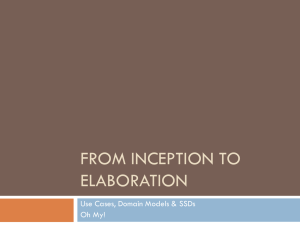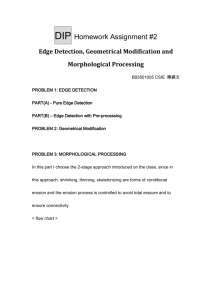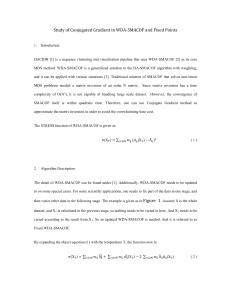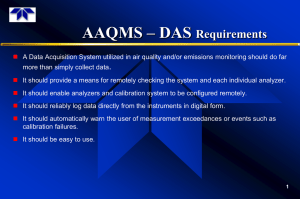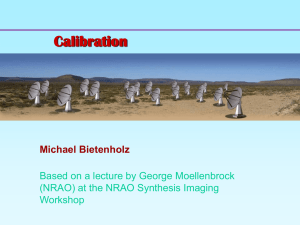Slides
advertisement
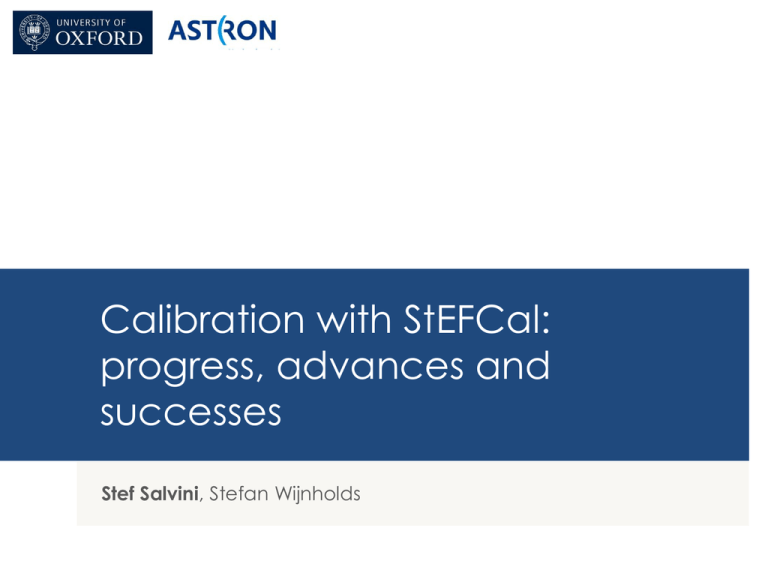
Calibration with StEFCal: progress, advances and successes Stef Salvini, Stefan Wijnholds The Problem Given D the observed visibility matrix , n the number of antennas M the model sky visibility matrix, Minimise where the Frobenius norm is the complex gains matrix G is diagonal with 2x2 blocks (one per antenna) Where each block is given by The Problem Poor scalability of traditional algorithms Convergence of StEFCal proven for non-polarized case O(n2) operations Extended here to polarized case O(n2) operations Iteratively minimize (normal equations method for SVD): where and the two columns of Z and D for the j-th antenna are referred by Zj , Dj namely The problem has split into n 2x2 systems of equations Algorithm Cost per iteration 44 n2 real operations Small memory footprint Only 2-4 extra vectors required Data access Unit stride across all items of data. Parallelism Very fine grain (each antenna computed independently) Synchronization 1 per iteration Typical number of iterations Varied, <= 100 for adequate convergence Algorithm Validation Alternative Algorithms Used for Results Comparison Name Description BFGS Alternative method using the BFGS method (developed and written by S.Salvini) LevenbergMarquardt Using the LM routine available from MATLAB (lsqnonlin) Other validation and skies Description Computation and checking of the gradient of the minimised function (its entries should be very small at a minimum) Simulated skies up to 100,000 sources, up to 1,000 calibration sources calibration sources with various degrees of separation from others (between 1 and 10 factor) corruption of gains: random phases; amplitude of diagonal elements between 0.2 and 2; off-2diagonal elements between 0 and 0.2 Real skies (ongoing) LOFAR (thanks to Tammo and Stefan) Meqtrees (Oleg Smirnov): using StEFcal routinely Example 100,000 sources Random position Intensity exponentialy distributed between 10-4 and 1 Random source polarization Geometric instrumental polarization included 256 antennas (512 dipoles) Baseline up to 250 metres For ease of imaging Simple DFT imaging All calibrations using Stefcal1c Histogram of source intensities Example Exact Sky Observed Sky Example Model include sources up to x % intensity of brightest Pictures show difference between exact and calibrated sky 10 % 1% Example Model include sources up to x % intensity of brightest Pictures show difference between exact and calibrated sky 0.1 % All sources Algorithm Variants Name Description 1-basic The basic algorithm Highly parallel (GPUs) 1-relax stefcal1a modified to use also G[i-2] and G[i-4] to compute G[i] (relaxation) Highly parallel (GPUs) 1-monitor Stefcal1b modified to act on convergence issues, monitoring the termination conditions Highly parallel (GPUs) 2-basic Stefcal1a using the latest value of G rather than from the previous iteration (cfr Gauss-Seidel vs. Jacobi iterations) No averaging step Parallel dependencies within each iteration (no GPUs) 2-relax Stefcal2a with relaxation No averaging step Parallel dependencies within each iteration (no GPUs) “Bootstrapping” StEFcal consists of solving a smaller problem to low accuracy to provide initial values for the iteration. Very effective! Comparing StEFCal Versions Performance with Problem Size Sky model including 512 dipoles 10,000 sources 30 calibration sources 100 iterations for all sizes Intel Xeon 2650 2.0 GHz (2.8 with turbo) 1 core used Double Precision Peak ~22 Gflops/sec per core from ZGEMM “Perfect” scaling Normalised to n = 500 Computational costs O(n2) Computational Costs Problem size No. iterations 50 136 100 122 200 128 300 84 400 90 500 82 600 100 800 76 1000 96 1500 72 2000 74 3000 84 4000 80 Time (sec) 0.005 0.005 0.019 0.027 0.051 0.072 0.125 0.177 0.370 0.617 1.121 2.849 4.794 Gflops/sec 3.10 10.85 11.95 12.19 12.40 12.56 12.67 12.07 11.43 11.54 11.62 11.68 11.75 % Peak (ZGEMM) 14.1% 49.3% 54.3% 55.4% 56.4% 57.1% 57.6% 54.8% 52.0% 52.5% 52.8% 53.1% 53.4% SKA-1 LFAA Station Calibration - 1 Description Number of antennas No. dipoles per antenna Total number of dipoles Number of frequencies Precision Convergence required Half-bandwidth for bootstrapping StEFcal Total Number of iterations for bootstrapping StEFcal Average N. Iteration for bootstrapping per frequency Total Number of iterations for full StEFcal Average N. Iteration for full StEFcal per frequency Total no. flops for bootstrap Total no. flops for full-size StEFcal Total number of operations (real flops) Value 256 2 512 1024 Single 1.00E-05 50 31875 31.1 19814 19.3 6.33E+10 2.08E+11 2.71E+11 SKA-1 LFAA Station Calibration - 2 No. cores Time (sec) Total (all freq) Gflops/sec % CGEMM n-core peak (CGEMM) 1 16.63 17.9 41.8% 42.9 2 8.34 35.8 41.9% 85.4 3 5.57 53.5 42.2% 126.9 4 4.19 71.2 41.8% 170.5 6 2.90 102.9 42.0% 244.9 8 2.35 127.0 42.2% 300.9 10 1.92 155.3 41.3% 375.6 12 1.72 173.3 38.3% 452.0 14 1.63 182.9 36.5% 501.4 16 1.54 194.2 41.7% 466.0 Scalability StEFCal in AARTFAAC (1) AARTFAAC: 288-antenna all-sky monitor for LOFAR Bi-scalar calibration: non-polarized StEFCal Factor 35 speed-up! N2 instead of N3 ~8x more iterations Net: 288/8 = 36 StEFCal in AARTFAAC (2) Tracking calibration Idea: exploit smooth behavior of gains over time Method: Use gain solution from previous iteration as initial guess Do only one (!) full-iteration of StEFCal Result: another factor of ~8 reduction Risk of solution wandering off with time Solution: calibration to convergence at regular intervals Ref: Prasad et al., A&A, in prep. (to be submitted soon) Current work Non-polarized StEFcal Extensions Minimization of phases only Minimization over multiple snapshots Linear and Polynomial calibration over multiple snapshots (both over time and frequency) Experimental code being tested and assessed Non-polarized case Polarized case Full-Pol StEFCal Testing within pipelines and real data (LOFAR, etc) Tammo’s previous talk Oleg Smirnov: sliding window, deep imaging with VLA Implementation on GPUs Any Questions ? Thank you! Any Questions?





